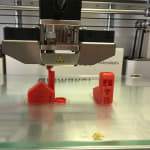 Recent growth of additive manufacturing has been dramatic and it is quickly approaching mainstream adoption. Today, a wide variety of materials can be 3D printed using the many platform technologies to build a large diversity of products and functional components for industrial usage. For plastic materials in particular, the transition from rapid prototyping to high volume production of functional parts means access to the right materials is critical.
Recent growth of additive manufacturing has been dramatic and it is quickly approaching mainstream adoption. Today, a wide variety of materials can be 3D printed using the many platform technologies to build a large diversity of products and functional components for industrial usage. For plastic materials in particular, the transition from rapid prototyping to high volume production of functional parts means access to the right materials is critical.Here, Manuel Delgado, Market Manager 3D Printing at raw material specialties distributor VELOX, outlines some of the new speciality raw materials available for the development of filaments and powders. The transition to functional part production is highly dependent on finding materials that not deliver only the necessary design accuracy but also the physical and mechanical properties essential for the application. In some areas, such as the aerospace and automotive sectors, additive manufacturing is mainstream. In others, such as the medical, healthcare, and food and packaging industries, the take-up to manufacture end-use parts has been glacial.
One of the main reasons for this is that many regulatory guidelines and standards preclude their use. Depending on whether the printed parts end up as a machine component, a cog wheel for example, or an elaborate food container different rules apply. In Europe, materials that come into direct contact with food need to be certificated to EU regulation 10/2011. For global use, they also need to be FDA-compliant.
Another, more prosaic, reason for the slow uptake of additive manufacturing in the food and medical industry is the surface finish. Both applications require cleanliness and must be sterile; the porous surfaces on a 3D printed part are particularly challenging where interconnectivity between layers takes place. The technique is acceptable for proof of concept but not in real-world applications. Here, parts need to be cleaned regularly with chemical and steam cleaners.
For Fused Deposition Modelling (FDM), also referred to generically as Fused Filament Fabrication (FFF), the two most common materials used are Acrylonitrile Butadiene Styrene (ABS) and Polylactic Acid (PLA). Both are thermoplastics, which when heated, become malleable allowing them to be moulded into different shapes prior to cooling. ABS is an oil-derived plastic and is commonly used to build strong and sturdy components, such as car parts. PLA, on the other hand, is made from organic materials. Its low melting point makes it easier and safer to handle, printed parts are susceptible to warping, cracking or melting.
Generally speaking, neither of these materials are suitable for use in the aforementioned heavily-regulated sectors, until now. As an established and independent distributor serving industries as diverse as healthcare, food processing and automotive, VELOX offers one of the broadest portfolios of raw plastic materials, from base polymers to additives. Specialist suppliers include SK Chemicals, Trinseo, Lubrizol and Carlfors Bruk – they produce raw materials that are FDA-compliant or medically certified, or have special characteristics, some of which are also well-suited for additive manufacturing.
With MAGNUM ABS, Trinseo offers a material that has undergone biocompatibility testing according to the ISO 10993 standard and is therefore medically-approved. This material also creates an excellent glossy appearance and good impact performance of the printed part, both characteristics that match the needs of the medical device sector. Another of Trinseo´s materials features excellent stability in high temperatures, non-halogenated ignition resistance and suitability in corrosive chemical environments. These are ideal characteristics for parts that require regular steam sterilisation or chemical washdowns. For PLA materials, one of the newly developed Skyplete grades by SK Chemicals has a heat resistance of up to 100 degC, post-annealing.



